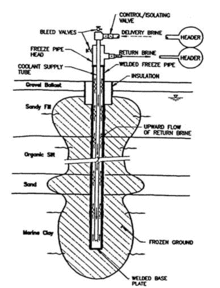

Ground freezing is a construction technique used in circumstances where soil needs to be stabilized so it will not collapse next to excavations, or to prevent contaminants spilled into soil from being leached away. Ground freezing has been used for at least one hundred years.
Pipes are run through the soil to be frozen, and then refrigerants are run through the pipes, freezing the soil. Frozen soil can be as hard as concrete.
Design
Some ground freezing projects use common salt brine as the refrigerant, but other projects benefit from using more exotic refrigerants, like liquid nitrogen.
Examples
Soil contaminated with radioactive elements that leaked from Japan's Fukushima Daiichi nuclear power plant was contained through ground freezing.
A project in Boston known as the Big Dig used ground freezing during some of its tunneling, to allow its wide tunnels to be built under or through soil that supported existing infrastructure that would have been difficult or expensive to support using more traditional excavation methods.
In northern Canada and arctic Alaska, passive pipe systems are used that do not require any external power to keep the ground frozen. These systems use in-ground evaporators and above-ground radiators filled with liquid refrigerant. When ambient temperatures fall below ground temperatures, the liquid vapor starts condensing in the radiator, reducing the pressure in the system causing the liquid in the evaporator to boil and evaporate. This process results in heat transfer from the ground to the air and keeps the ground in a permanent frozen state.
Hani and Evirgen (2023) introduced a new method for sampling granular soils without disturbing their natural state; they suggest using artificial ground freezing, a ground enhancement technique, as an on-site option for deep excavation applications.
See also
- Pykrete, a composite building material which utilizes similar properties in frozen sawdust, Hani and Evirgen investigated the mechanical and microstructural properties of an artificially frozen Sawdust-Ice mixture (Pykrete) and its usability as a retaining structure. In addition, they developed an uncoupled thermo-hydro-mechanical approach to simulate a pykrete diaphragm wall for numerical analysis using finite element methods.
References
- ^
Jessica Morrison (2013-10-30). "How Engineers Use Ground Freezing to Build Bigger, Safer, and Deeper". PBS. Archived from the original on 2014-04-11. Retrieved 2014-07-22.
The basic premise behind ground freezing is that soil—made up of bits of minerals and organic matter, water, and air—becomes stronger and less penetrable when its water freezes and expands.
-
"Technical Manual for Design and Construction of Road Tunnels - Civil Elements". US Department of Transport. Archived from the original on 2013-12-05. Retrieved 2014-07-22.
In order to maintain support to the tunnel face, excavation and jacking normally carried out alternately in small increments, typically in the range of 2 to 4 feet. In most cases, the soft ground must be treated by means of ground improvement techniques such as ground freezing, jet grouting, etc. as discussed in Chapter 7 Soft Ground Tunneling to enhance its stand up time.
-
"Ground Freezing: Freezing soil with liquid nitrogen". The Linde Group. 2014. Archived from the original on 2014-02-26. Retrieved 2014-07-22.
During the last two decades soil freezing with liquid nitrogen (LIN) has developed from an exotic gas application with many uncertainties into a standard procedure for treating unstable soil and leakages.
-
Igor Holubec, Ph.D., P.Eng (2014). "Flat Loop Thermosyphon Foundations in Warm Permafrost" (PDF). Government of the NT Asset Management Division Public Works and Services. Archived (PDF) from the original on 2015-04-02. Retrieved 2015-06-12.
Passive cooling by means of pressured heat exchange pipes was developed in Alaska by the U.S. Army Corps of Engineers in 1965 to preserve foundations in 'warm' permafrost.
{{cite news}}: CS1 maint: multiple names: authors list (link) -
"Thermosyphon Technology for Ground Freezing". 2014. Archived from the original on 2014-11-26. Retrieved 2015-06-12.
The basis of thermosyphon thechnology is a heat transfer device (thermosyphon) which extracts the heat from the soil during winter and passes it to the environment.
- Hani, Mostefa; Evirgen, Burak (2023). "A frozen soil sampling technique for granular soils and thermal modeling". Bulletin of Engineering Geology and the Environment. 82 (9): 354. doi:10.1007/s10064-023-03372-4.
- Hani, Mostefa; Evirgen, Burak (2023). "The Mechanical and Microstructural Properties of Artificially Frozen Sawdust–Ice Mixture (Pykrete) and Its Usability as a Retaining Structure". International Journal of Civil Engineering. 21: 119-134. doi:10.1007/s40999-022-00751-y.
- Hani, Mostefa; Evirgen, Burak (2024). "Uncoupled thermo-hydro-mechanical modeling of a pykrete diaphragm wall for an alternative artificial ground freezing application". Computers and Geotechnics. 169: 106243. doi:10.1016/j.compgeo.2024.106243.
| Geotechnical engineering | |||||||
|---|---|---|---|---|---|---|---|
| Offshore geotechnical engineering | |||||||
| Investigation and instrumentation | |||||||
| Soil |
| ||||||
| Structures (Interaction) |
| ||||||
| Mechanics |
| ||||||
| Numerical analysis software | |||||||
| Related fields | |||||||